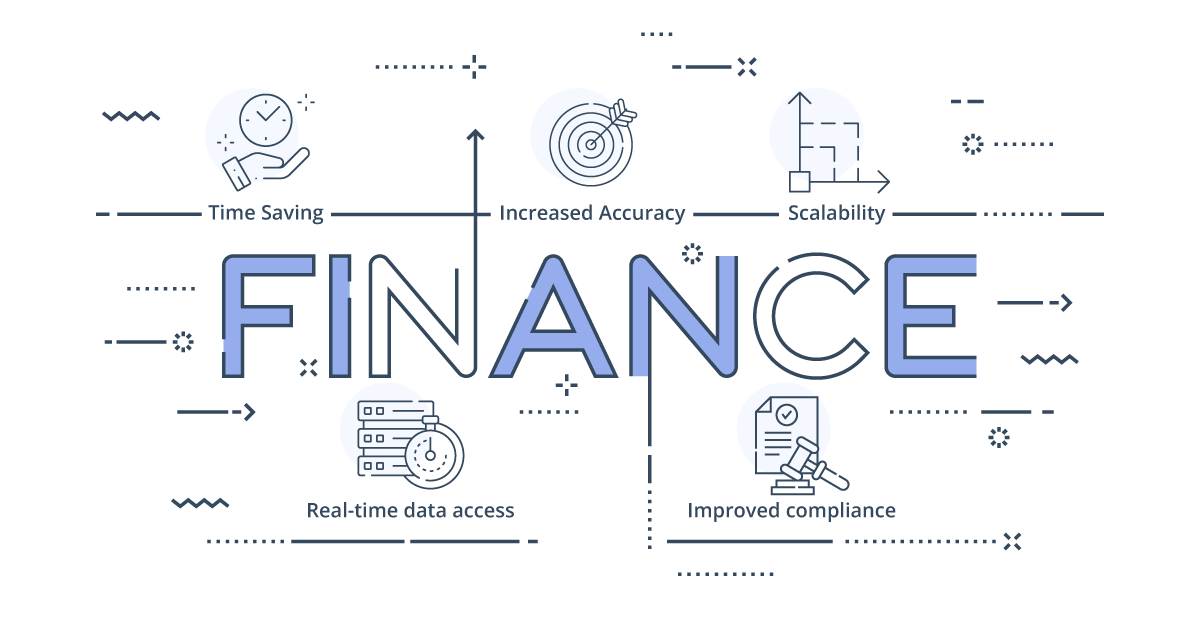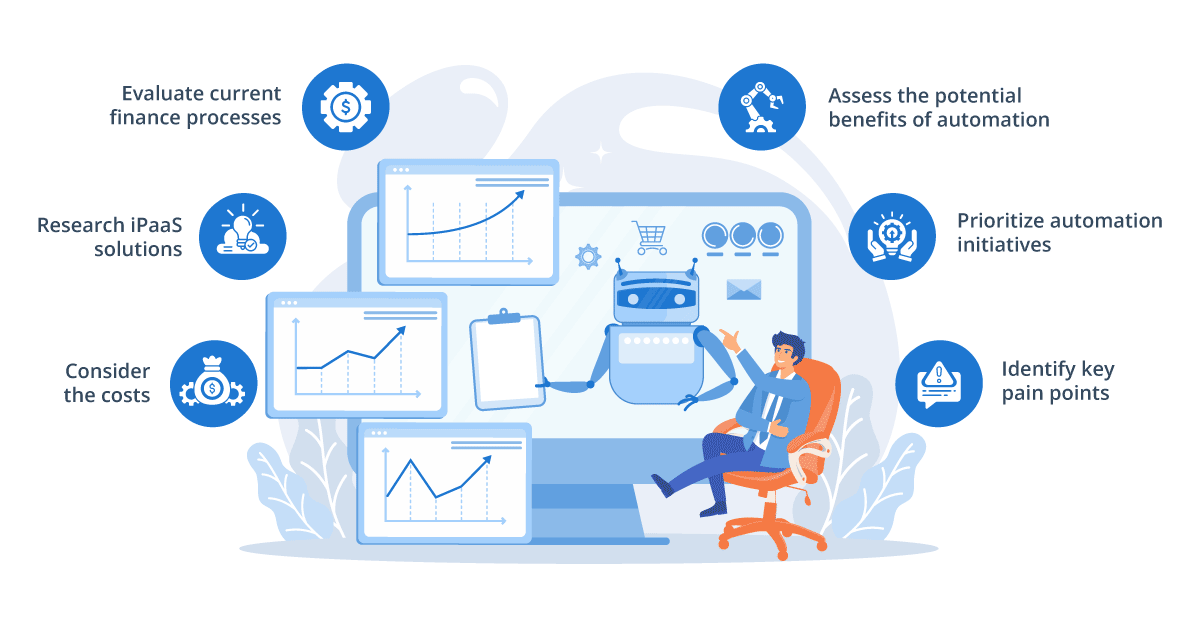The finance department of any organization plays a vital role in managing the financial well-being of a company. It is responsible for ensuring that the company’s financial transactions are accurate, timely, and in compliance with regulatory requirements. However, with the increasing complexity of financial operations and the need for real-time data access, traditional methods of managing financial information are becoming obsolete.
This is where iPaaS comes into play. iPaaS, or Integration Platform as a Service, is a cloud-based solution that enables organizations to connect and integrate different software applications, systems, and data sources. With iPaaS, the finance department can streamline its operations, automate manual tasks, and gain access to real-time financial data.
Aonflow iPaaS – Free for First 3 Months!
Build and run up to 1,500 transactions monthly with no cost. No payment info needed!
Let’s talk about challenges in finance without automation
There are numerous challenges that finance departments may face when they rely on manual processes and lack automation. Some of the most common challenges include:
Human errors: One of the most significant challenges of manual processes is the high probability of human error. Manual data entry and processing can lead to data entry errors, miscalculations, and other mistakes, which can have a negative impact on financial statements and decision-making.
Time-consuming: Manual processes can be incredibly time-consuming, which can hinder the ability of finance departments to respond quickly to business needs. Tasks like data entry, reconciliation, and reporting can take hours or even days to complete, leaving finance teams with less time to focus on higher-value activities.
Lack of real-time data: Without automation, finance departments may struggle to obtain real-time data, which can limit their ability to make informed decisions. This can be especially problematic in today’s fast-paced business environment, where timely decision-making is critical.
Compliance risks: Manual processes can increase the risk of non-compliance with regulatory requirements. With a lack of automation, finance departments may struggle to keep up with changing regulations and may inadvertently violate compliance requirements.
Limited scalability: Manual processes can be difficult to scale as the business grows. As the organization expands, manual processes may become increasingly complex, making it challenging to manage financial operations efficiently.
Manual financial processes can present significant challenges for finance departments, including human errors, time-consuming tasks, a lack of real-time data, compliance risks, and limited scalability. By automating financial operations, organizations can streamline processes, reduce errors, increase efficiency, and gain access to real-time data, which can lead to improved financial performance and a competitive advantage in the marketplace.
The importance of finance automation
Finance automation is becoming increasingly important in today’s fast-paced business environment. It involves the use of technology to streamline financial processes, reduce errors, and increase efficiency. There are several key reasons why finance automation is important:
Time savings: One of the most significant benefits of finance automation is the time savings it can provide. Automation can eliminate manual data entry and processing, freeing up time for finance professionals to focus on higher-value activities like analysis and strategy development.
Increased accuracy: Finance automation can reduce errors and improve accuracy in financial processes. Automated processes are less prone to human errors, which can lead to inaccurate financial statements, data, and decision-making.
Real-time data access: Automation can provide real-time access to financial data, enabling finance departments to make more informed decisions in real time. This is especially important in today’s fast-paced business environment, where timely decision-making is critical.
Improved compliance: Finance automation can help ensure compliance with regulatory requirements. Automation can provide audit trails, ensure consistent application of policies and procedures, and reduce the risk of non-compliance.
Scalability: Finance automation can improve scalability by enabling finance departments to handle increasing volumes of financial data and transactions as the business grows. Automated processes can adapt to changing business needs, reducing the need for additional staff or resources.
Finance automation is critical for modern finance departments. It can save time, increase accuracy, provide real-time data access, improve compliance, and improve scalability. By leveraging automation technologies, organizations can streamline financial processes, reduce errors, and gain a competitive advantage in the marketplace.
What does finance automation entail?
Finance automation entails using technology to streamline financial processes and reduce manual work. This can involve various tools and techniques to automate different finance-related activities, such as:
Invoice processing: Automation can be used to process invoices automatically, including capturing and verifying data, and reconciling payments. This can significantly reduce the time and effort required for manual invoice processing.
Payment processing: Automated payment processing can help to streamline the payment process, including the initiation and processing of payments, tracking, and reconciliation.
Reporting and analysis: Automation can be used to generate financial reports and perform financial analysis. This can include automating the consolidation of financial data from various sources, creating financial statements, and generating custom reports for stakeholders.
Compliance: Automation can be used to ensure compliance with regulatory requirements, including automating compliance checks, providing audit trails, and ensuring consistent application of policies and procedures.
Budgeting and forecasting: Finance automation can help to streamline the budgeting and forecasting process, including automating data collection, creating financial models, and generating reports.
Reconciliation: Automation can be used to reconcile financial transactions, including bank reconciliations, invoice reconciliations, and account reconciliations.
Cash management: Finance automation can help to manage cash flows, including automating cash forecasting, cash positioning, and cash sweeps.
Finance automation entails using technology to streamline financial processes and reduce manual work. This can involve automating invoice and payment processing, reporting and analysis, compliance, budgeting and forecasting, reconciliation, and cash management.
Finance automation in a post-COVID world
The COVID-19 pandemic has accelerated the adoption of finance automation, and its importance in a post-COVID world is now more apparent than ever. Here are some ways finance automation is likely to play a crucial role in the post-COVID world:
Remote work: The pandemic has forced many businesses to adopt remote work, and finance automation has helped ensure that financial processes can continue uninterrupted despite the remote nature of work. Automation tools can be accessed from anywhere, allowing finance teams to work remotely while maintaining high levels of productivity and efficiency.
Cost optimization: The pandemic has forced many organizations to rethink their cost structures, and finance automation can help to optimize costs by reducing the need for manual work, improving accuracy, and streamlining financial processes. This can result in significant cost savings and enable organizations to operate more efficiently.
Risk management: The pandemic has highlighted the need for effective risk management, and finance automation can help organizations to manage financial risks more effectively. Automation tools can provide real-time data and insights, enabling finance departments to make informed decisions and respond to risks quickly.
Agile decision-making: In a post-COVID world, organizations need to be agile and adaptable to change, and finance automation can help finance departments respond quickly to changing business needs. Automation can provide real-time data, enabling finance departments to make informed decisions and respond to changes in the business environment quickly.
Compliance: The pandemic has increased regulatory scrutiny, and finance automation can help organizations to ensure compliance with regulatory requirements. Automation tools can provide audit trails, ensure consistent application of policies and procedures, and reduce the risk of non-compliance.
In the wake of the COVID-19 pandemic, finance automation is set to play a pivotal role in reshaping how organizations manage their financial processes. iPaaS (Integration Platform as a Service) emerges as a key enabler, offering seamless connectivity between disparate financial systems, data sources, and applications. This integration empowers organizations to operate with heightened efficiency, effectively manage financial risks, respond promptly to changing conditions, and uphold compliance with regulatory mandates.
How to ascertain if you need to automate Finance Processes using iPaaS?
Determining whether your organization needs to automate finance processes using iPaaS (Integration Platform as a Service) involves evaluating the current state of your finance operations and identifying areas where automation could provide significant benefits. Here are some steps you can take to ascertain if you need to automate finance processes using iPaaS:
Evaluate current finance processes: Start by assessing the current state of your financial operations, including manual processes, the technology stack in use, and the level of automation already in place. Identify areas where manual work is still required, and determine the bottlenecks that slow down your finance operations.
Identify key pain points: Based on your evaluation, identify the key pain points in your finance operations. These may include issues such as data entry errors, delays in processing invoices, or difficulty generating timely financial reports.
Assess the potential benefits of automation: Once you’ve identified your key pain points, assess the potential benefits of automation for each area. This can include increased efficiency, reduced errors, improved compliance, real-time data access, and cost savings.
Research iPaaS solutions: Research iPaaS solutions that can address your pain points and provide the necessary automation. Look for solutions that offer pre-built connectors to your existing systems, and that can automate workflows and processes with minimal coding.
Consider the costs: Consider the costs of implementing an iPaaS solution, including the costs of licensing, development, and ongoing maintenance. Evaluate whether the benefits of automation justify the investment.
Prioritize automation initiatives: Once you’ve identified the areas where automation can provide the most significant benefits, prioritize your automation initiatives based on their potential impact on your finance operations and the organization as a whole.
Figuring out whether your organization needs to automate finance processes using iPaaS involves evaluating the current state of your finance operations, identifying key pain points, assessing the potential benefits of automation, researching iPaaS solutions, considering the costs, and prioritizing automation initiatives. By taking these steps, you can determine whether automation is the right choice for your organization and identify the areas where automation can provide the most significant benefits.
Aonflow is the leading integration platform.
You can kick-start by integrating your first-ever workflow in just a matter of minutes.
Finance process & management automation
Vendor Onboarding: Automating vendor onboarding processes ensures that the necessary documents, agreements, and information are collected and reviewed efficiently. This reduces manual paperwork, accelerates approval cycles, and enhances vendor relationship management.
Payment Reconciliation: Automating payment reconciliation tasks involves matching incoming payments with corresponding invoices or orders. This process reduces discrepancies, identifies discrepancies more quickly, and improves accuracy in financial records.
Tax Compliance: Automation aids in managing tax compliance by calculating taxes accurately, generating tax reports, and ensuring timely submission of tax returns. It minimizes errors, avoids penalties, and simplifies the complex landscape of tax regulations.
Credit Control: Automating credit control processes assists in monitoring customer credit limits, sending payment reminders, and managing overdue accounts. This enhances cash flow management and reduces the risk of bad debts.
Audit Trail Creation: Automation generates detailed audit trails of financial transactions, providing a comprehensive record of who accessed, modified, or approved financial data. This strengthens accountability, transparency, and internal controls.
Investment Portfolio Management: For finance departments handling investments, automation can aid in managing investment portfolios, tracking performance, analyzing risk, and generating reports for stakeholders and regulatory authorities.
Employee Expense Validation: Automating employee expense validation ensures that submitted expenses comply with company policies before approval. It streamlines the approval process, reduces errors, and enhances policy adherence.
Finance process and management automation can be achieved through the use of various technologies, such as iPaaS (Integration Platform as a Service), RPA (Robotic Process Automation), and AI (Artificial Intelligence). These technologies can be used to automate repetitive tasks, streamline workflows, and enable real-time data access, enabling finance teams to work more efficiently and effectively. By automating finance processes and management tasks, organizations can achieve significant cost savings, reduce errors, and enable better decision-making.
As finance departments seek greater efficiency and accuracy, embracing automation across various processes and management tasks becomes essential. iPaaS-driven automation empowers finance teams to allocate their efforts toward strategic analysis and decision-making, ultimately driving business growth.
What should the automation roadmap for finance look like?
Creating an automation roadmap for finance involves identifying key finance processes and management tasks that can be automated and prioritizing them based on their potential impact and feasibility. Here are some steps to consider when creating an automation roadmap for finance:
Assess the current state: Start by evaluating the current state of your finance operations, including the technology stack in use, the level of automation already in place, and the pain points that need to be addressed.
Identify the key processes: Identify the key finance processes and management tasks that can be automated, such as invoice processing, financial reporting, account reconciliation, budgeting and forecasting, expense management, cash management, and compliance management.
Prioritize the initiatives: Prioritize the automation initiatives based on their potential impact on finance operations and the organization as a whole, as well as their feasibility and complexity.
Develop a roadmap: Develop a detailed roadmap for implementing the automation initiatives, including timelines, resources required, and milestones.
Choose the right technologies: Choose the right technologies to automate finance processes and management tasks, such as iPaaS, RPA, and AI. Consider factors such as cost, ease of implementation, and compatibility with existing systems.
Test and refine: Test and refine the automation solutions to ensure they meet the desired objectives and make adjustments as necessary.
Monitor and optimize: Monitor the automation solutions and optimize them over time to ensure they continue to meet the organization’s needs and provide maximum benefits.
It’s important to note that creating an automation roadmap for finance is an ongoing process, and it’s essential to continuously assess the organization’s needs and identify new opportunities for automation. By following these steps and continuously refining the automation roadmap, organizations can achieve significant cost savings, improve accuracy, and enable better decision-making.
What parts of finance operations should be automated using iPaaS?
iPaaS (Integration Platform as a Service) is a cloud-based platform that enables the integration of multiple systems and applications, making it an ideal tool for automating finance operations. Here are some of the finance operations that can be automated using iPaaS:
Invoice processing: iPaaS can be used to integrate the invoice processing system with the accounting system, enabling real-time data transfer and reducing manual data entry.
Financial reporting: iPaaS can integrate data from various sources, such as ERP (Enterprise Resource Planning) systems, CRM (Customer Relationship Management) systems, and other financial systems, to enable real-time reporting and analysis.
Account reconciliation: iPaaS can automate the account reconciliation process by integrating data from bank statements, accounting systems, and other sources to identify discrepancies and streamline the reconciliation process.
Budgeting and forecasting: iPaaS can integrate data from various sources to enable real-time budgeting and forecasting, allowing finance teams to make more informed decisions.
Expense management: iPaaS can automate the expense management process by integrating data from various sources, such as credit card statements and expense reports, to enable faster and more accurate expense tracking and reimbursement.
Cash management: iPaaS can integrate data from various sources, such as bank statements and accounting systems, to enable real-time cash management and forecasting.
Compliance management: iPaaS can integrate data from various sources, such as regulatory systems and compliance management tools, to enable real-time compliance monitoring and reporting.
By automating these finance operations using iPaaS, organizations can achieve significant cost savings, reduce errors, and enable better decision-making. It’s important to note that the specific finance operations that should be automated using iPaaS will depend on the organization’s needs and the specific systems and applications in use. A thorough assessment of the finance operations and existing technology infrastructure can help identify the best areas for automation using iPaaS.
Why Aonflow iPaaS for finance automation?
There are several reasons why Aonflow iPaaS (Integration Platform as a Service) is a good choice for finance automation. Firstly, Aonflow iPaaS provides a user-friendly interface and a drag-and-drop workflow builder, making it easy to integrate multiple systems and applications without the need for extensive coding or IT expertise. This ease of integration saves time and resources, allowing finance teams to focus on more strategic tasks.
Secondly, Aonflow iPaaS offers a wide range of connectors, allowing organizations to easily integrate with a variety of systems and applications. This flexibility is particularly valuable in finance, where organizations may use a variety of systems and applications for different tasks, such as accounting software, ERP (Enterprise Resource Planning) systems, and compliance management tools.
Thirdly, Aonflow iPaaS is a cloud-based platform, that enables real-time data transfer and analysis. This real-time data transfer is particularly valuable in finance, where timely and accurate data is essential for decision-making. Real-time data transfer also reduces errors and delays associated with manual data entry.
Fourthly, Aonflow iPaaS offers advanced automation capabilities, such as RPA (Robotic Process Automation) and AI (Artificial Intelligence). These capabilities enable organizations to automate more complex finance tasks, such as account reconciliation and financial forecasting and improve accuracy and efficiency.
Finally, Aonflow iPaaS provides robust security features, such as encryption and multi-factor authentication, to ensure the confidentiality and integrity of financial data. This is particularly important in finance, where data security and compliance are critical.
In summary, Aonflow iPaaS is a comprehensive and flexible platform that can help organizations automate finance operations and improve accuracy, efficiency, and decision-making. Its ease of integration, wide range of connectors, real-time data transfer, advanced automation capabilities, and robust security features make it an excellent choice for finance automation.
Aonflow iPaaS – Free for First 3 Months!
Build and run up to 1,500 transactions monthly with no cost. No payment info needed!


